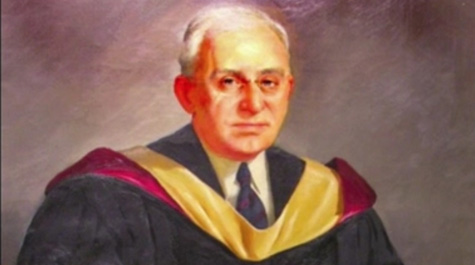Earl Gregg Swem, architect of a great library
Swem Library is named in honor of Earl Gregg Swem, who served as the college librarian at William & Mary from 1920 to 1944. Under his leadership, the library collection grew from 25,000 books and 20,000 manuscripts to more than 240,000 books and 400,000 manuscripts. Swem also made the library more accessible by offering classes on library use and, in a practice almost unheard of at that time, opening the stacks to students and the public.
“Earl Gregg Swem was instrumental in acquiring the manuscript collections that came to form the foundation for the Special Collections Research Center,” said University Archivist Kim Sims. “He also worked tirelessly to both document the university's early history, which wasn't an easy task considering most of the university records were destroyed in the 19th century Wren Building fires, and solicit manuscripts related to the College of William & Mary to supplement the records that somehow managed to survive the fires.”
{{youtube:medium:center|rzOJQA-k63c, Swem's legacy lives on}}
Swem made it his mission and passion to collect Virginia history. He reached out to families and individuals asking about papers, and he diligently followed up and developed relationships. He extolled the virtues of the library to anyone who would listen. He also went above and beyond to help those interested in Virginia history. Jay Gaidmore, director of the library’s Special Collections Research Center, shared a particular occasion that led to the acquisition of one of the library’s most prized collections.
“One summer day, W&M President J.A.C. Chandler summoned Dr. Swem to his office. There waiting were two women from Kentucky, who wanted Dr. Swem to accompany them to their ancestral tombs in Surry County. He agreed, of course, even though he was not sure of the tombs’ exact location. The next day they made their way to Surry County. One of the women was so pleased with his courtesy that she decided to donate 145 original Thomas Jefferson letters who had been written to her ancestor, William Short,” Gaidmore said. “Dr. Swem’s wife said he was so excited that he didn’t sleep for days.”
His collecting efforts became so well known that people started contacting him. He developed relationships with collectors, including Charles Henry Taylor, Jr. (1867-1941), treasurer and director of the Boston Globe Newspaper Company, who donated the first edition of the Book of Mormon to Swem Library. Dealers of rare books and manuscripts reached out to him as well.
Swem authored, edited or compiled numerous works on Virginia history. His most famous work, the Virginia Historical Index, was compiled while he worked at William & Mary. “Swem’s Index,” as it is often called, remains an invaluable resource for genealogists and historians of Virginia.
“It is a treasure trove of information,” said genealogist Mary Beth Dalton, who frequently uses the Swem Library’s genealogy resources for her research. “The index is the best resource for searching Virginia periodicals. It can help you find a needle in a haystack.”
Prior to arriving at W&M, Swem served as chief of the catalog division at the Library of Congress in 1903 and assistant librarian at what is now the Library of Virginia from 1907 to1920. Although a native of Iowa, Swem always felt a calling to return to Virginia, the home of his ancestors.
“Dr. Swem once said, ‘All of this time I was gravitating toward my great love – Virginia.’ For this reason, I feel a strong kinship to Earl Gregg Swem. Although I grew up in New Hampshire, I had ancestors who lived in Virginia back in the 1600s and 1700s, and as a result, I have always felt a connection to Virginia and its history,” said Gaidmore.
Swem died at the age of 94 in 1965, a year before the completion of the library that bears his name.















